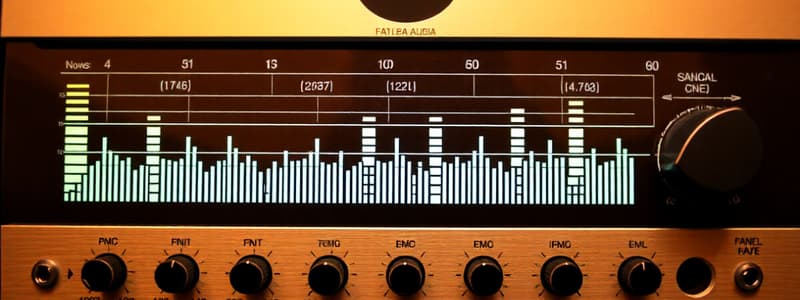Podcast
Questions and Answers
What is the main purpose of the Nyquist Theorem in digital audio?
What is the main purpose of the Nyquist Theorem in digital audio?
- To increase the bit depth of an audio sample
- To determine the best audio file format for compression
- To ensure samples are taken at a rate that prevents distortion (correct)
- To synchronize multiple digital audio devices
Which audio file format is considered compressed and lossy?
Which audio file format is considered compressed and lossy?
- MP3 (correct)
- AIFF
- WAV
- FLAC
How does increasing the sample rate affect digital audio files?
How does increasing the sample rate affect digital audio files?
- Has no effect on audio quality or file size
- Increases audio fidelity but also increases file size (correct)
- Reduces dynamic range of the audio
- Decreases audio fidelity while lowering file size
What does bit depth primarily influence in digital audio?
What does bit depth primarily influence in digital audio?
Which of the following is NOT a key property of audio files?
Which of the following is NOT a key property of audio files?
What role does dither play in digital audio processing?
What role does dither play in digital audio processing?
Which component is essential for recording audio in a digital workspace?
Which component is essential for recording audio in a digital workspace?
What is the primary function of word clock in digital audio?
What is the primary function of word clock in digital audio?
What is the minimum sample rate required to accurately capture a 10 kHz audio signal?
What is the minimum sample rate required to accurately capture a 10 kHz audio signal?
What is the primary advantage of using oversampling in digital audio?
What is the primary advantage of using oversampling in digital audio?
What happens when the sample rate is lower than the frequency of the audio signal?
What happens when the sample rate is lower than the frequency of the audio signal?
What is the relationship between sample rate and CPU load?
What is the relationship between sample rate and CPU load?
What is the purpose of an anti-aliasing filter in digital audio?
What is the purpose of an anti-aliasing filter in digital audio?
What is the primary factor that determines the quality of an uncompressed digital audio file?
What is the primary factor that determines the quality of an uncompressed digital audio file?
Which of the following compressed audio file formats is considered lossless?
Which of the following compressed audio file formats is considered lossless?
What is the relationship between sample rate and file size?
What is the relationship between sample rate and file size?
What is the primary function of bit depth in digital audio?
What is the primary function of bit depth in digital audio?
Which of the following statements about audio file extensions is true?
Which of the following statements about audio file extensions is true?
Flashcards are hidden until you start studying
Study Notes
Digital Audio Overview
- Converts analog signals into digital data through Analog-to-Digital Conversion.
- A sample acts as a snapshot of an audio signal, resembling frames in video.
- Sample Rate is the frequency of samples per second; standard CD audio operates at 44.1 kHz (44,100 samples/sec).
- Nyquist Theorem dictates the sample rate must be at least twice the highest frequency to prevent aliasing. Use anti-aliasing filters to remove undesirable frequencies.
Audio File Attributes
- File Formats:
- Uncompressed formats include WAV and AIFF.
- Compressed options are MP3, FLAC, and Dolby AC3.
- Key Properties:
- Sample Rate influences audio quality and file size.
- Bit Depth refers to the number of bits per sample, affecting audio resolution and dynamic range.
- Channels can be mono, stereo, or multi-channel.
- Compression can be lossy (e.g., MP3) or lossless (e.g., FLAC).
Sample Rate and Bit Depth
- Higher Sample Rate increases fidelity but also raises file size and processing requirements. Lower rates save space but may diminish quality.
- Bit Depth defines bits per sample; higher values yield greater dynamic range and reduced quantization errors.
- Common Bit Depths:
- CDs utilize 16-bit.
- DVDs/Blu-ray typically feature 24-bit.
- Digital Audio Workstations (DAWs) support options from 16 to 32 bits.
- Dithering introduces low-level noise to mitigate errors in lower bit depths.
Word Clock
- Word Clock ensures synchronization among digital audio devices for enhanced sample accuracy.
- High-quality clocks cut down on jitter, which involves phase distortions.
- Various Connection Types include AES, S/PDIF, ADAT, and BNC (coaxial).
Recording Setup Essentials
- A powerful Computer with high RAM and SSD is crucial for digital audio workstations (DAWs).
- Choose a Digital Audio Workstation (DAW) according to individual workflow needs (e.g., Pro Tools, Logic).
- Utilize an Audio Interface such as Focusrite Scarlett or Universal Audio Apollo Twin.
- A quality Microphone is vital for effective recording, while headphones are useful for initial mixing stages.
Digital Audio Documents
- Emphasize organized DAW File Management to maintain session files.
- Ensure audio files remain within their respective parent folders for proper functioning in software like Pro Tools.
Digital Audio Introduction
- Analog to digital conversion: Attributes of an audio file include file format, data rate, channels (mono, stereo, or multi-channel), sample rate quality, and sample (a single measurement of amplitude of a continuous analog signal, also known as a snapshot or reading of an instance of audio).
- Sample rate: the number of samples or measurements of amplitude taken per second of an analog signal; CD Audio has a sample rate of 44.1 kHz, meaning the A/D converter takes 44,100 measurements of amplitude per second.
- Nyquist Theorem: the sample rate must be at least double the highest frequency of the signal to faithfully encode it in the digital domain.
- A single sine wave requires 2 samples per frame (one for peak, one for valley).
- Higher sample rate = higher fidelity, better quality, bigger file size, and more CPU load.
- Lower sample rate = lower quality, smaller file sizes, but not always lower quality if the audio is low Hz.
- Aliasing occurs if the signal is above the Nyquist Frequency, causing distortion; anti-aliasing filters eliminate the problematic frequencies.
Oversampling
- Sampling a signal many times higher than the selected sample rate and Nyquist frequency to avoid aliasing.
- Sampling at the highest possible frequency to account for all lower frequencies without aliasing.
Bit Depth
- Bit depth: the number of bits of information available for each sample, directly corresponding to the resolution of each sample.
- Pulse-code modulation (PCM) is used to digitally represent sampled analog signals.
- Bit depth affects the noise level from quantization error, signal-to-noise ratio (SNR), dynamic range, bit rate, and file size.
- Examples of bit depths: CD = 16 bits per sample, DVD + BluRay = 24 bits per sample, and most DAWs support 16, 24, or 32-bit audio.
- Higher bit depth is better for recording because it sets the clipping point.
Dithering
- Adds low-level noise to get rid of quantization errors, reducing harmonic distortion.
- Dithering fills in the blanks, making the "stair-step" effect less drastic.
- We now have a white noise floor instead of peaks in the noise floor due to harmonic distortion.
- The point of dithering is to reduce truncation when lowering bit depth.
Word Clock
- A master word clock is required to unify devices with different sample rates.
- AKA Primary and Secondary (instead of Master and Slave).
- Word clock tells an A/D or D/A converter when to take the sample, firing an impulse 44.1k (or 48k, or 96k, etc) times per second.
- Jitter is manifested in audio as phase distortions and discrepancies, particularly in the higher frequencies.
Audio File Manipulation
- Optimizing: preparing a source/raw media file for playback on a target system, usually involving conversion to a smaller (and usually lower quality) format.
- Optimizing reduces file size and data rate for storage and network transfer.
- Transcoding: digital-to-digital conversion of one file format to another without involving an optimizing (compression etc) process.
- Transcoding may incur quality loss and is often carried out to convert an obsolete format to a current one.
Codecs
- Codec: short for compression-decompression algorithm, employed to compress and decompress media files.
- Codecs can be lossy or lossless.
- Lossless compression reduces file size without losing information.
- Lossy compression reduces file size dramatically but affects quality.
DAW Voices
- Pro Tools, Reason, and Logic have a limit to the amount of voices/tracks they can use simultaneously.
Non-Destructive Editing
- Destructive editing: trimming and effects process the file, making changes permanent upon saving.
- Non-destructive editing: trimming and effects create cue points, allowing changes to be reverted.
Importing/Exporting Audio Files
- In most DAWs, you can import audio, video, and MIDI information, and export the same.
- Reason: import audio file, import MIDI file, export MIDI file, export song as audio file, export loop as audio file, and bounce mixer channels.
- Logic: import logic projects, audio file, MIDI file, Final Cut Pro XML, AAF, and other; export selection as MIDI file, track as audio file, all tracks as audio files, project as AAF file, project to Final Cut Pro/XML, and score as MusicXML.
Studying That Suits You
Use AI to generate personalized quizzes and flashcards to suit your learning preferences.




